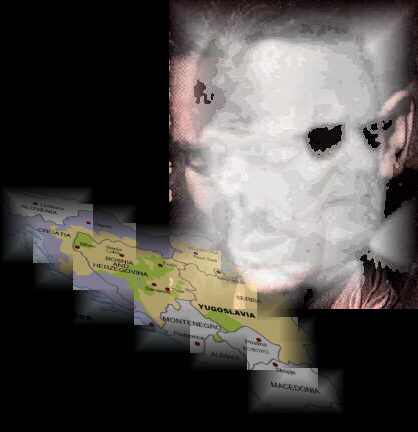 On June 17, 1977, in Restaurant MIRA, at Kronprinzestrasse 6, Stuttgart, Germany, a U.S. Major, Special Plans and Operations, asked:
On June 17, 1977, in Restaurant MIRA, at Kronprinzestrasse 6, Stuttgart, Germany, a U.S. Major, Special Plans and Operations, asked:"What is to become of Yugoslavia when President Tito dies?"
 On June 17, 1977, in Restaurant MIRA, at Kronprinzestrasse 6, Stuttgart, Germany, a U.S. Major, Special Plans and Operations, asked:
On June 17, 1977, in Restaurant MIRA, at Kronprinzestrasse 6, Stuttgart, Germany, a U.S. Major, Special Plans and Operations, asked:
"What is to become of Yugoslavia when President Tito dies?"
Yugoslav Colonel, Defense Attache in West Germany, responded quickly and directly:
"That is taken care of.".
He later said that one of his major duties was to identify Yugoslav guest workers in FRG who came under military obligation to their home country...
Communist countries of Eastern Europe functioned like 19th century countries where the government was a sort of an umbrella corporation that oversaw, guided and directed other corporate entities including the media in the given country, while in The Western 20th century countries the government serves more like a clearing house for the special interests of other corporations (including the media). With the Constitution of 1974 Yugoslavia became a bastard between two centuries: the Republics basically became functioning as independent, competing corporations, i.e. the federal government worked as a Western 20th century model, and 6 republics and 2 autonomous provinces governments worked as the "communist" 19th century model, holding near absolute power over their economies.
 After president's Tito death in 1980, those corporations started
fiercely competing to gain the monopoly on the federal power.
Industrial powerhouses Slovenia and Croatia used economy as
a weapon, while Serbia having the biggest population decided
to threat others with the "people". Initially the war was fought
through media, corporate boards, trading agreements and
intelligence pranks.
After president's Tito death in 1980, those corporations started
fiercely competing to gain the monopoly on the federal power.
Industrial powerhouses Slovenia and Croatia used economy as
a weapon, while Serbia having the biggest population decided
to threat others with the "people". Initially the war was fought
through media, corporate boards, trading agreements and
intelligence pranks.
 In 1987/88 Slobodan Milosevic rose to power in Serbia. He
used "spontaneous demonstrations" to install his puppet
people in governments of autonomous provinces of Kosova
and Vojvodina and republic of Montenegro, building a bloc of
4 votes in 8-headed Yugoslav presidency. The balance was
tilted to his side and Slovenia and Croatia started openly
discussing re-arranging of the federation and/or secession
from it.
In 1987/88 Slobodan Milosevic rose to power in Serbia. He
used "spontaneous demonstrations" to install his puppet
people in governments of autonomous provinces of Kosova
and Vojvodina and republic of Montenegro, building a bloc of
4 votes in 8-headed Yugoslav presidency. The balance was
tilted to his side and Slovenia and Croatia started openly
discussing re-arranging of the federation and/or secession
from it.
Slovenia did it first. Yugoslav Army offered mostly symbolic resistance and retreated it's troops and hardware to Croatia and Bosnia. Slovenia, the only former Yugoslav republic with the borders with The West, therefore became a sort of a buffer zone between the Europe and the Balkans, protecting the former from the spread of the later.
In Croatia local Serbs, following Yugoslav Army's retreat from Slovenia, built up an insurgency in Knin/Krajina region, cutting Croatia in half. Krajina sits in the narrowest point of Croatia's horseshoe like territory - right between coastal and continental Croatia. With Slovenia "keeping guard" in the North, and closed roads to the sea, Croatia was effectively cut-off from the West (read: arms, supplies, food, etc.). Easy prey for Yugoslav Army, which then started the attack on Slavonia.
Yet they did not shell industrial potential. They concentrated on objects of culture (churches) and on residential objects. They just wanted people out, it seemed. Fiercest attacks were thrown on the city of Vukovar, at the far flung end of Croatia's horse-shoe, with no obvious military value.
Tudjman swallowed the bait and sent his minuscule army to protect Vukovar asking them to fight there till the last men.
| At that point Yugoslav Army started shelling Dubrovnik, at the other far flung end of Croatia's horse-shoe. Again, they did not bomb military objects, airports, but residences and objects of culture (which Dubrovnik does not lack). With no access to the coast, because of the Krajina blockade, and with most of the troops and weapons in Slavonia, Croatia stood no chances to protect Dubrovnik and the rest of Dalmatia. It was a chess-mate position. Tudjman continued to ask his men to keep fighting in Vukovar, but he sent the weapons, ear-marked for Vukovar, to Dalmatia through Hercegovina (republic of Bosnia-Hercegovina). Vukovar fell and the commander responsible for its defense was later jailed by Tudjman for not evacuating on time (although it is dubious if the order to retreat was ever issued). It is easy to understand why Dalmatia was more valuable to Tudjman than Slavonia and his military decision to sacrifice Vukovar for Dubrovnik is perfectly sane. But that weapons never came there. They did not just pass through Hercegovina. They stayed there. |

|
Yugoslav Army, nevertheless, stopped shelling Dubrovnik and other Dalmatian cities at that point. They left without the fight, as they left Slovenia once before. As if they got what they wanted from Croatia now, too.
Hercegovina is a part of Bosnia-Hercegovina populated mostly by ethnic Croats. Croats from Hercegovina are the most numerous among Croat emigres, they have money and they hold a great political sway over Tudjman's government. Weapons that came to Hercegovina had to pass through both Bosnian-Muslim controlled territory (around Bihac, at that time controlled by Fikret Abdic, who obviously let them through, and now is hated by Alija Izetbegovic for that and lives in Croatia) and Serb controlled territory: Serbs perhaps let them through knowing that they would never leave Bosnia.
 With that set-up the siege of Sarajevo begun. Yet again,
industrial and military objects were spared, but residential
areas and objects of culture were shelled at will. In a sort of a
Blitzkrieg' Bosnian Serbs (with weapons, logistics and under
the command of Yugoslav Army officers) seized half of Bosnian
territory in matter of months. Central Bosnian triangle (Tuzla-Zenica-Sarajevo) became completely cut-off from the rest of
the world: on three sides (N,W,E) it was surrounded by newly
proclaimed Republika Srpska, while the South was guarded by
Hercegovina (Croats). No-fly zone was imposed by NATO to pre-empt the possibility
of aerial bombardment of the triangle'. Milosevic kept his
hands on Croatian oil resources in Slavonia and on Krajina -
still disabling the traffic between coastal and continental
Croatia, thus assuring Croatia's loyalty in Bosnia with a
simple choke hold. Mitterand walked down the Sarajevo's
Main Street and concluded how safe it was. Massacres in
Rwanda followed shortly after.
In this war of rapidly shifting alliances, Alija suddenly decided
to deliver a blow to Serbs at the furthest end of his state:
Bihac. With the help of Croatia, Bihac was turned under
control of Bosnian government. While the 5th corps was
taking Bihac, Izetbegovic was telling his commanders in
Eastern Bosnia, what Tudjman told once to the defenders of
Vukovar: stay there till the last men. Srebrenica and Zepa
were overrun and people were massacred. City defense
commanders were later jailed by Izetbegovic for not evacuating
city on time (deja-vu?). CIA took nice aerial pictures of the
mass graves but kept them secret for about three weeks and
let a young American journalist be jailed by Serbs. UN
soldiers, however, timely left.
With that set-up the siege of Sarajevo begun. Yet again,
industrial and military objects were spared, but residential
areas and objects of culture were shelled at will. In a sort of a
Blitzkrieg' Bosnian Serbs (with weapons, logistics and under
the command of Yugoslav Army officers) seized half of Bosnian
territory in matter of months. Central Bosnian triangle (Tuzla-Zenica-Sarajevo) became completely cut-off from the rest of
the world: on three sides (N,W,E) it was surrounded by newly
proclaimed Republika Srpska, while the South was guarded by
Hercegovina (Croats). No-fly zone was imposed by NATO to pre-empt the possibility
of aerial bombardment of the triangle'. Milosevic kept his
hands on Croatian oil resources in Slavonia and on Krajina -
still disabling the traffic between coastal and continental
Croatia, thus assuring Croatia's loyalty in Bosnia with a
simple choke hold. Mitterand walked down the Sarajevo's
Main Street and concluded how safe it was. Massacres in
Rwanda followed shortly after.
In this war of rapidly shifting alliances, Alija suddenly decided
to deliver a blow to Serbs at the furthest end of his state:
Bihac. With the help of Croatia, Bihac was turned under
control of Bosnian government. While the 5th corps was
taking Bihac, Izetbegovic was telling his commanders in
Eastern Bosnia, what Tudjman told once to the defenders of
Vukovar: stay there till the last men. Srebrenica and Zepa
were overrun and people were massacred. City defense
commanders were later jailed by Izetbegovic for not evacuating
city on time (deja-vu?). CIA took nice aerial pictures of the
mass graves but kept them secret for about three weeks and
let a young American journalist be jailed by Serbs. UN
soldiers, however, timely left.
Amidst the hype, Croats (with American 'non-governmental' help) took over Krajina. Serbs did evacuate on time (after Vukovar and Srebrenica they probably did not want to take any chances) creating the largest single exodus in this war. Milosevic's propaganda machinery was just warming up to talk about Ustashas, when the Srebrenica's mass graves (satellite pictures were leaked out) became the media darling and the turning point in the US Bosnia policy.
Dayton accord followed with an empty promise of the unified Bosnia, basically placing Bosnia under foreign military control, while cementing the existing partition and containing the war in a few contested areas like Brcko and Mostar. Milosevic, meanwhile, became the target of the same medicine he used to apply to his enemies: "spontaneous demonstrations".
Croat and Serb entities in Bosnia largely depend on the support from their motherlands. With the change in governments of Croatia and Serbia to such that would not support partition of Bosnia, Dayton accords might be fully implemented. However, nobody knows when that change would come, if ever (but it is clear why the US favors it).
